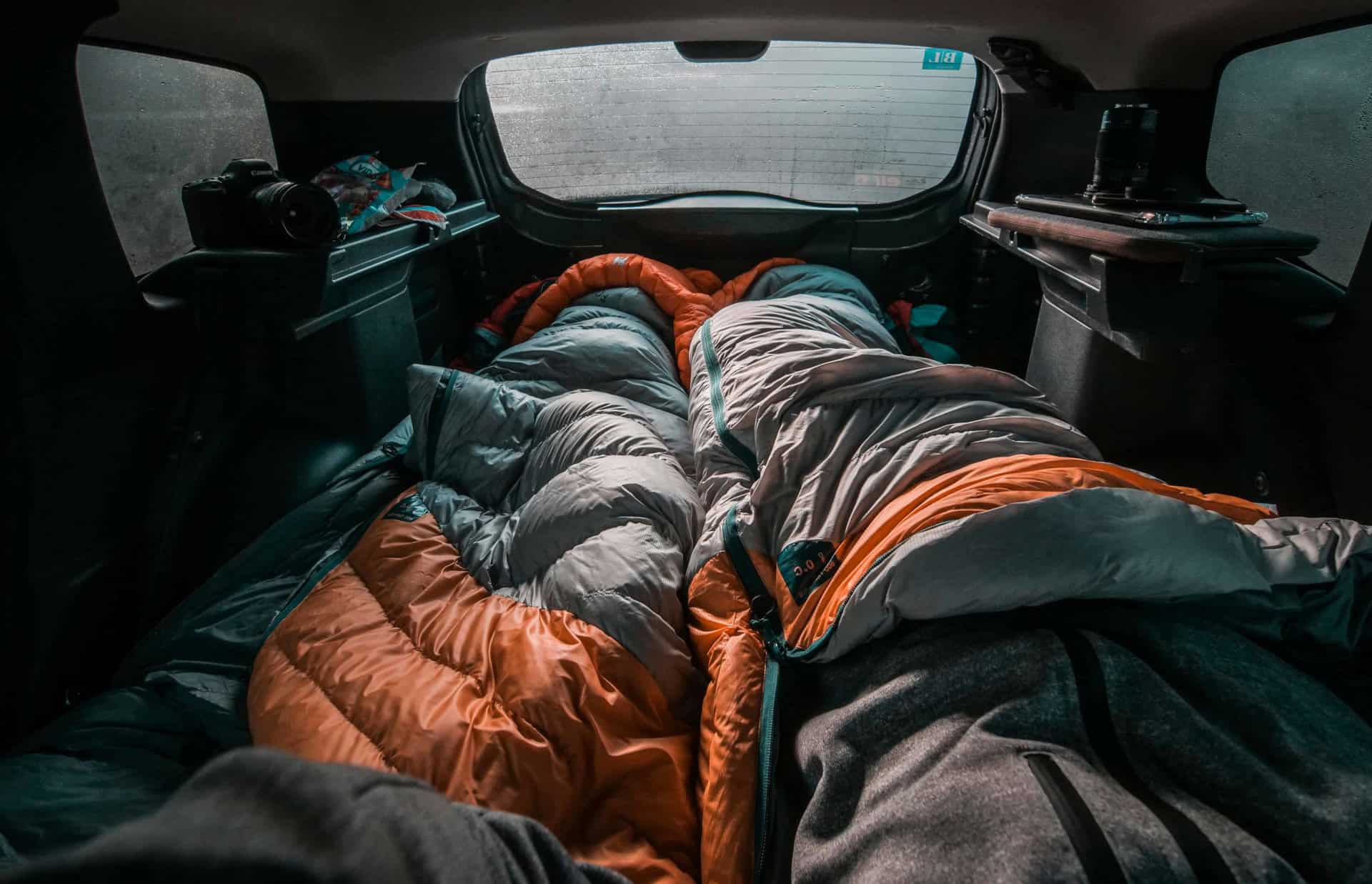What is a Sleeping Bag and Why Do You Need One?
A sleeping bag is more than just a cozy cover for your outdoor adventures—it's your portable shelter against the cold, wind, and even moisture. Whether you're planning to camp under the stars in the Rockies or set up your tent in the damp forests of the Pacific Northwest, the right sleeping bag can mean the difference between a restful night and a miserable one.
How Does a Sleeping Bag Work?
At its core, a sleeping bag is designed to trap your body heat, creating a warm pocket of air around you. Insulated with materials like down or synthetic fibers, the bag reduces heat loss and blocks cold air from entering. Depending on the design—mummy-shaped or rectangular—sleeping bags can offer varying degrees of heat retention, comfort, and mobility.
"A well-insulated sleeping bag isn't just a camping accessory—it's a lifeline for cold-weather adventurers."
Key Reasons You Need a Sleeping Bag
- Warmth and Insulation: A quality sleeping bag keeps you warm by maintaining a layer of air heated by your body. Mummy-style bags, like those by Marmot or The North Face, excel at this due to their snug fit.
- Comfort: Even in less extreme conditions, a sleeping bag provides a padded layer between you and the ground. Many campers combine them with sleeping pads from brands like Therm-a-Rest for maximum comfort.
- Portability: Unlike blankets or comforters, sleeping bags are designed to be lightweight and packable. Take the Mountain Hardwear Phantom, for example—its down fill allows it to compress easily while maintaining excellent warmth-to-weight ratio.
When Do You Absolutely Need One?
While some may argue you can make do with blankets in warmer weather, the moment temperatures drop, having a well-rated sleeping bag is non-negotiable. Whether you're trekking in Yosemite or hiking through Appalachian Trail during fall, nighttime temperatures can plummet unexpectedly, and that's when a 3-season or 4-season sleeping bag becomes essential.
| Scenario | Recommended Sleeping Bag Type |
|---|---|
| Summer camping in moderate climates | Lightweight synthetic or down bag, 3-season rated |
| Winter camping or high-altitude expeditions | Heavy-duty down-filled mummy bag, 4-season rated |
| Backpacking with unpredictable weather | Hybrid or synthetic mummy bag with water-resistant shell |
More Than Just Survival—It's About Comfort
Think of your sleeping bag as an essential piece of gear, just like your boots or backpack. It's not just about surviving the night—it's about enjoying it. Brands like Kelty and Outdoor Research understand this balance, offering bags that provide both comfort and durability, ensuring a good night's sleep, even after a tough day on the trail.
If you're looking for more than basic protection, consider features like zipper draft tubes, insulated hoods, or even built-in pillow pockets. These additions—available in high-end models from Mountain Hardwear or Sea to Summit—can make a real difference when temperatures drop or the ground beneath your tent is uneven.
So, why do you need a sleeping bag? Because it's the cornerstone of a good camping experience. A warm, comfortable place to rest lets you recharge and be ready for the next adventure. Whether you're camping, hiking, or backpacking, you'll want to invest in a sleeping bag that's suited to your needs, your climate, and your budget.
Types of Sleeping Bags
Choosing the right sleeping bag is essential to ensure a comfortable and warm night in the great outdoors. The type of sleeping bag you select can impact not only your comfort but also how easily it fits into your overall camping or backpacking setup. Below, we'll break down the key sleeping bag types, their features, and when they work best.
Mummy Sleeping Bags
Mummy sleeping bags are a top choice for cold-weather campers. Their snug, tapered design reduces the amount of air around your body, helping to trap and retain warmth more effectively than other shapes. These bags are perfect for those who want to stay warm in freezing conditions without carrying extra weight. Brands like The North Face and Marmot are known for producing high-quality mummy bags with a balance of insulation and portability.
- Down-Filled Mummy Bags: Down-filled bags, especially those using high-quality goose or duck down, are renowned for their superior warmth-to-weight ratio. For example, the Marmot Lithium 0°F bag is a favorite among winter backpackers for its exceptional warmth and compressibility.
- Synthetic-Filled Mummy Bags: Synthetic insulation, like Primaloft or standard polyester, offers better performance in wet conditions. The Mountain Hardwear Lamina series is a standout for those needing reliable insulation in damp environments.
Rectangular Sleeping Bags
Rectangular sleeping bags are ideal for those who prioritize space and comfort over heat retention. Unlike mummy bags, these have a more open shape, allowing for more movement inside. While they aren't as efficient at trapping heat, they provide a more relaxed sleeping experience—great for car camping or mild summer trips.
Brands like Kelty and Coleman specialize in rectangular bags that are both durable and comfortable. If you're planning on a family camping trip where weight isn't an issue, rectangular sleeping bags are a great option.
- Best for Warm Weather: Rectangular bags are popular for summer camping. Models like the Kelty Callisto 30 are spacious, affordable, and easy to use in milder temperatures.
- More Room to Move: If you're the type who tosses and turns at night, a rectangular bag offers enough space to shift positions without feeling confined.
Hybrid Sleeping Bags
Hybrid sleeping bags combine the heat retention of mummy bags with the extra space of rectangular designs. These are versatile options for campers who want the best of both worlds. The tapered footbox helps retain warmth, while the roomier upper section gives you a bit more wiggle room.
One example is the NEMO Riff, which blends both shapes into a bag that's suitable for colder temperatures but still provides comfort for side sleepers and restless campers.
Comparing Sleeping Bag Types
| Sleeping Bag Type | Pros | Cons | Best For |
|---|---|---|---|
| Mummy | Excellent heat retention, lightweight, compact | Can feel restrictive | Cold-weather backpacking |
| Rectangular | Spacious, comfortable, great for warm weather | Less heat efficient, bulkier | Car camping, casual trips |
| Hybrid | Balance of warmth and space, versatile | Heavier than mummy bags | 3-season camping, side sleepers |
Choosing the Right Type for Your Needs
Ultimately, the right sleeping bag type depends on how and where you'll be camping. If you're backpacking in cold conditions, a mummy bag is hard to beat. For campers focused on comfort during mild weather, a rectangular bag may be your best bet. And if you want a versatile option, the hybrid bag provides a great balance of features.

Sleeping Bag Insulation: Down vs. Synthetic
When it comes to choosing the best sleeping bag, the type of insulation plays a critical role in determining how warm, lightweight, and compressible your bag will be. The two primary options you'll encounter are down insulation and synthetic insulation. Each has its own advantages and trade-offs, so let's take a closer look at both to help you decide which is best for your camping needs.
Down Insulation
Down insulation, derived from the soft undercoating of ducks or geese, is widely regarded for its superior warmth-to-weight ratio. Known for its loft and compressibility, down is the go-to choice for backpackers and mountaineers who need the lightest and warmest gear available.
- Goose Down: Goose down is typically of higher quality, offering better warmth and compressibility compared to duck down. The Marmot Plasma 30 is a prime example of a goose down sleeping bag, providing remarkable warmth without adding unnecessary weight.
- Duck Down: Slightly less expensive than goose down, duck down is still an excellent insulator and is used in more budget-friendly models like the REI Magma 15. It's a great option if you want good insulation without breaking the bank.
Down is highly compressible, meaning it packs down small and is easy to carry on longer treks. However, it does have a significant drawback: it loses its insulating properties when wet. For this reason, many modern down sleeping bags include a DWR (Durable Water Repellent) coating to protect the insulation from moisture.
"Down sleeping bags are unparalleled in warmth-to-weight ratio but come with the caveat of moisture sensitivity. If you're in a dry environment, down is unbeatable."
Synthetic Insulation
Synthetic insulation is made from man-made materials like polyester, designed to mimic down's ability to trap heat, but with better performance in wet conditions. Unlike down, synthetic insulation retains its ability to keep you warm even when exposed to moisture, making it ideal for camping in damp environments.
- Polyester: The most common type of synthetic insulation, polyester is durable, affordable, and dries quickly. Sleeping bags like the Kelty Tuck 20 offer reliable warmth with polyester fill and are perfect for all-around camping use.
- Primaloft: Known for its ability to closely mimic the loft and warmth of down, Primaloft insulation is lightweight and offers superior performance in wet weather. The Mountain Hardwear Lamina 30 is an excellent example of a sleeping bag that uses Primaloft to provide warmth even when conditions are less than ideal.
While synthetic sleeping bags tend to be bulkier and heavier than their down counterparts, they have the advantage of being more budget-friendly and better suited to wet conditions. If you're planning a trip where rain or high humidity is likely, synthetic insulation will keep you warm and dry without sacrificing too much comfort.
Comparing Down vs. Synthetic Insulation
| Insulation Type | Pros | Cons | Best For |
|---|---|---|---|
| Goose Down | Best warmth-to-weight ratio, highly compressible, long-lasting | Expensive, loses insulation when wet | Cold, dry conditions, backpacking, mountaineering |
| Duck Down | More affordable than goose down, good insulation | Heavier and less compressible than goose down | 3-season camping, budget-conscious backpacking |
| Synthetic (Polyester) | Affordable, insulates when wet, dries quickly | Heavier and bulkier, less durable over time | Damp environments, budget-conscious campers |
| Primaloft | Great wet-weather performance, lightweight, compressible | Still bulkier than down, more expensive than polyester | Wet climates, all-season camping, lightweight backpacking |
Which Insulation is Right for You?
The choice between down and synthetic insulation depends on your camping environment and budget. If you're venturing into cold, dry regions or need a lightweight option for long-distance hiking, down insulation is hard to beat. However, if you expect rain, humidity, or you're looking for a more affordable option, synthetic insulation offers reliable warmth without the risk of losing heat when wet.
For many, a well-balanced bag like the REI Magma 15 (down) or the Kelty Cosmic 20 (synthetic) provides an excellent combination of warmth, weight, and durability. Both materials have their place, and your personal preference and specific adventure plans will dictate the best choice.
Understanding Sleeping Bag Temperature Ratings
One of the most important factors when choosing a sleeping bag is its temperature rating. The right rating ensures you'll stay warm and comfortable in the environments you're camping in. Temperature ratings can be confusing, but once you understand the categories and how they're determined, selecting the right sleeping bag becomes a whole lot easier.
How Are Temperature Ratings Determined?
Most sleeping bags are rated based on the EN (European Norm) 13537 or ISO 23537 standards. These tests measure the temperature range at which a sleeping bag will keep an average sleeper warm. Manufacturers generally provide three key ratings:
- Comfort Rating: The lowest temperature at which an average person can sleep comfortably. This rating is often based on a standard female sleeper.
- Lower Limit Rating: The lowest temperature at which an average male can sleep without feeling cold.
- Extreme Rating: The survival rating, indicating the temperature at which the bag will keep you alive, but likely not comfortable. It's the absolute minimum temperature a bag can handle before you start experiencing severe cold stress.
When choosing a sleeping bag, it's best to focus on the comfort rating if you want to ensure a good night's sleep, particularly if you tend to feel cold easily.
3-Season vs. 4-Season Sleeping Bags
Sleeping bags are often categorized as 3-season or 4-season, depending on their temperature ratings. These labels help you choose the right bag for the specific weather conditions you'll encounter on your trip.
3-Season Sleeping Bags
Designed for spring, summer, and fall, 3-season sleeping bags usually have a temperature range of 20°F to 35°F (-6°C to 2°C). They are versatile and lightweight, making them popular among backpackers and campers who need gear that performs well across different conditions.
- Marmot Trestles 30: A popular 3-season bag that balances weight, warmth, and affordability, making it a solid choice for most outdoor enthusiasts.
- REI Co-op Trailbreak 30: Offers a mix of synthetic insulation and durability at an accessible price, perfect for weekend backpackers.
If you're camping in mild to cool weather and don't expect temperatures to dip below freezing, a 3-season sleeping bag will provide ample warmth and comfort without the bulk of a 4-season bag.
4-Season Sleeping Bags
4-season sleeping bags are built for winter and high-altitude camping. They typically have temperature ratings below 20°F (-6°C), and many can handle sub-zero temperatures. These bags often feature more insulation, draft collars, and hoods to retain as much body heat as possible.
- Mountain Hardwear Phantom 0°F: A top-rated option for extreme cold conditions, featuring premium down insulation for unmatched warmth.
- The North Face Inferno -20°F: One of the most trusted sleeping bags for mountaineering and arctic expeditions, providing reliable insulation at extreme temperatures.
If you're heading into snowy, high-altitude regions or camping in freezing winter temperatures, a 4-season sleeping bag is essential for survival and comfort.
Extreme Cold Sleeping Bags
For those adventuring into sub-zero environments, extreme cold sleeping bags are specifically engineered to keep you warm in temperatures below 0°F (-18°C). These bags are often overbuilt with features like draft tubes, extra layers of insulation, and water-resistant shells to ensure no warmth escapes.
The Western Mountaineering Puma GWS is one such bag, offering protection down to -25°F (-32°C) with an exceptional warmth-to-weight ratio. These types of sleeping bags are primarily designed for mountaineers, winter trekkers, and polar expeditions.
Choosing the Right Temperature Rating
The right temperature rating for your sleeping bag depends on the coldest temperature you expect to encounter on your trip. It's always a good idea to select a bag that's rated slightly lower than the coldest expected temperature, as factors like wind, humidity, and personal cold tolerance can impact your warmth.
| Type | Temperature Range | Best For |
|---|---|---|
| 3-Season Sleeping Bag | 20°F to 35°F (-6°C to 2°C) | Spring, Summer, and Fall Camping |
| 4-Season Sleeping Bag | Below 20°F (-6°C) | Winter and High-Altitude Camping |
| Extreme Cold Sleeping Bag | Below 0°F (-18°C) | Sub-Zero Environments, Expeditions |
Additional Tips for Staying Warm
Temperature ratings are a good guideline, but there are additional steps you can take to stay warm in your sleeping bag:
- Wear dry, moisture-wicking layers to bed to avoid getting damp inside your sleeping bag.
- Use a sleeping pad, like the Therm-a-Rest NeoAir XTherm, which provides insulation between your body and the cold ground.
- Consider using a liner to add extra warmth to your bag, such as the Sea to Summit Reactor, which can increase warmth by up to 15°F.
Now that you understand how temperature ratings work, you're well-equipped to choose the right sleeping bag for your adventures.
Key Features to Look for in a Sleeping Bag
A sleeping bag's features can make a huge difference in your overall comfort and warmth during your outdoor adventures. When you're in the market for a sleeping bag, it's important to consider these essential features that can enhance performance and usability. From hoods to zippers, each part plays a role in ensuring a restful night.
Hood
A well-designed hood can be the key to staying warm in cold temperatures. Most mummy-style sleeping bags include an adjustable hood that fits snugly around your head to minimize heat loss. The Marmot Helium series, for example, includes a full hood with a drawstring closure to keep your head warm on chilly nights.
"The body loses a significant amount of heat through the head, so a snug, insulated hood can be the difference between a restful night and a freezing one."
Zipper
A smooth, high-quality zipper is essential for both ventilation and ease of use. Many sleeping bags, such as those from The North Face, feature two-way zippers, allowing you to open the bottom for ventilation while keeping the top zipped up for warmth. Some designs also include anti-snag features that prevent the zipper from getting caught in the fabric, making it easier to open and close the bag.
Draft Tubes
Draft tubes are long pieces of insulated fabric that run alongside the zipper to prevent cold air from sneaking in through the zipper line. These are especially useful in colder climates, ensuring that your sleeping bag remains sealed and warm throughout the night. The Kelty Cosmic Down 20 is a great example of a sleeping bag with an effective draft tube system.
Compression Straps
Compression straps are a critical feature for backpackers who need to save space in their packs. These straps allow you to compress the sleeping bag into a more compact shape, making it easier to carry on the trail. Some sleeping bags, like the Mountain Hardwear Bishop Pass, come with their own compression sacks, while others may require you to purchase one separately.
Footbox
A well-designed footbox provides extra space for your feet, allowing them to rest naturally without being cramped. Some sleeping bags, like the NEMO Disco, feature a spoon-shaped design that gives extra room around the feet for side-sleepers or those who move around in their sleep. A shaped footbox not only adds comfort but also enhances warmth by reducing dead space.
Pillow Pockets
Some sleeping bags include built-in pillow pockets, which allow you to insert a small pillow or stuff a jacket for extra head support. This can add a layer of comfort without having to bring a separate camping pillow. The Sea to Summit Spark Ultralight series incorporates pillow pockets into its lightweight design.
Comparison of Key Features
| Feature | Function | Example Model |
|---|---|---|
| Hood | Reduces heat loss from the head | Marmot Helium |
| Two-way Zipper | Allows for ventilation and temperature control | The North Face Furnace 20 |
| Draft Tubes | Prevents cold air from seeping through the zipper | Kelty Cosmic Down 20 |
| Compression Straps | Compresses the sleeping bag for easier packing | Mountain Hardwear Bishop Pass |
| Footbox | Provides extra space for feet, enhancing warmth | NEMO Disco |
| Pillow Pocket | Offers convenient head support | Sea to Summit Spark Ultralight |
These features aren't just bells and whistles—they're designed to enhance your experience in the wilderness, ensuring warmth, comfort, and ease of use. By selecting a sleeping bag with the right features, you can tailor your gear to match your camping style and the environments you explore.
Fabrics Used in Sleeping Bags: Durability, Comfort, and Water Resistance
The fabric used in a sleeping bag is one of the most important factors affecting its overall performance. The right material provides not only durability but also comfort and water resistance, ensuring that your bag stands up to the elements while keeping you warm and dry. Let's explore the most common fabrics used in sleeping bags and how each one impacts your camping experience.
Nylon
Nylon is a popular choice for sleeping bag shells because of its lightweight, durable, and water-resistant properties. It's highly versatile and commonly found in many high-end bags. The Mountain Hardwear Phantom series, for instance, uses ripstop nylon for its outer shell, making it resistant to tears and abrasions while still keeping the bag light for backpacking.
Nylon also offers some degree of water resistance, though it's often paired with a DWR (Durable Water Repellent) coating to further protect against moisture. However, it can sometimes feel less breathable, so it's essential to balance durability with comfort, especially if you're in warmer climates.
Polyester
Polyester is another common fabric used in sleeping bags, especially in more affordable models. While slightly heavier than nylon, polyester offers good durability and is often softer to the touch, enhancing comfort for campers who prioritize coziness over packability. The Kelty Cosmic 20 sleeping bag uses polyester for its shell and lining, providing a good balance between affordability and durability.
- Durable and affordable: Polyester tends to be more budget-friendly, making it an excellent choice for beginner campers.
- Comfortable: The softer feel of polyester often makes it more comfortable for casual camping trips.
Ripstop Fabric
Ripstop fabrics, made from either nylon or polyester, are designed to resist tearing. They are woven in a crosshatch pattern that strengthens the fabric, making it perfect for rugged outdoor use. If you're backpacking in challenging terrains or are rough on your gear, a sleeping bag made from ripstop fabric, such as the Outdoor Research Helium, will give you peace of mind, knowing your bag can withstand abrasions from rocks, branches, or other sharp objects.
Water Resistance and Breathability
Many high-quality sleeping bags are coated with a DWR (Durable Water Repellent) finish to add a layer of water resistance. While this does not make the bag fully waterproof, it helps prevent moisture from soaking into the insulation. Bags like the REI Magma 15 come with a DWR finish, which can make a huge difference during unexpected weather changes.
However, breathability is equally important. While a waterproof bag may keep you dry, it can also trap moisture from your body, leading to condensation inside the bag. Striking a balance between water resistance and breathability is essential, especially if you're camping in humid environments.
Comparing Fabric Types
| Fabric | Pros | Cons | Example Model |
|---|---|---|---|
| Nylon | Lightweight, durable, water-resistant | Less breathable in warm conditions | Mountain Hardwear Phantom |
| Polyester | Soft, comfortable, affordable | Heavier than nylon | Kelty Cosmic 20 |
| Ripstop | Highly durable, tear-resistant | Can be heavier than regular nylon | Outdoor Research Helium |
Choosing the Right Fabric for Your Needs
The fabric of your sleeping bag should match the environments and conditions you plan to camp in. If you need a lightweight, packable option for backpacking, nylon or ripstop nylon is your best bet. For more casual or car camping, polyester provides more comfort at a lower cost. Always consider whether you'll need extra water resistance, and look for fabrics with a DWR finish if wet weather is in the forecast.
Essential Sleeping Bag Accessories
While a high-quality sleeping bag is crucial for a comfortable night outdoors, certain accessories can greatly enhance your sleeping system. From ensuring better insulation to making packing and setup easier, these accessories are must-haves for any camping or backpacking trip.
Stuff Sack
A stuff sack is an essential tool for keeping your sleeping bag compressed and protected when it's not in use. Most sleeping bags come with their own stuff sacks, but there are many aftermarket options that provide better compression or waterproofing. The Sea to Summit eVent Compression Dry Sack, for example, allows you to compress your bag while keeping it dry in wet conditions, making it a great option for backpackers.
"The right stuff sack not only saves space in your pack but also adds an extra layer of protection from the elements."
Sleeping Pad
To maximize warmth and comfort, pair your sleeping bag with a good-quality sleeping pad. A sleeping pad acts as a barrier between you and the cold ground, providing insulation and cushioning. One of the top-rated options is the Therm-a-Rest NeoAir XTherm, which offers an impressive warmth-to-weight ratio, making it ideal for cold-weather camping. For warmer conditions or casual camping, the NEMO Switchback foam pad is a popular, budget-friendly choice.
- Insulation: A sleeping pad with a high R-value will provide more insulation, which is crucial in colder climates.
- Comfort: Thicker pads generally offer more cushioning, making them perfect for car camping or side sleepers.
Pillow
A dedicated camping pillow adds an extra layer of comfort to your sleep system. Some sleeping bags come with built-in pillow pockets, but if yours doesn't, consider bringing a lightweight inflatable or compressible pillow like the Sea to Summit Aeros Pillow. It's easy to pack and inflates in seconds, offering firm support for your head and neck without adding significant weight to your gear.
Sleeping Bag Liner
Using a sleeping bag liner can extend the life of your bag by keeping it clean and adding extra warmth. Liners, such as the Sea to Summit Reactor Thermolite Liner, can boost the temperature rating of your bag by up to 15°F. They are also easier to wash than the sleeping bag itself, making them a practical accessory for multi-day trips.
Compression Sacks
In addition to a stuff sack, a compression sack can help you minimize the size of your sleeping bag even further, which is especially helpful for backpackers with limited space. Compression sacks like the Outdoor Research Ultralight Compression Sack use straps to reduce the bag's volume, allowing for a more compact packing solution.
Accessories Comparison
| Accessory | Function | Example Model |
|---|---|---|
| Stuff Sack | Keeps the sleeping bag compact and protected | Sea to Summit eVent Compression Dry Sack |
| Sleeping Pad | Provides insulation and cushioning from the ground | Therm-a-Rest NeoAir XTherm |
| Pillow | Offers head and neck support while sleeping | Sea to Summit Aeros Pillow |
| Sleeping Bag Liner | Adds warmth and protects the sleeping bag from dirt | Sea to Summit Reactor Thermolite Liner |
| Compression Sack | Compresses the sleeping bag for easier packing | Outdoor Research Ultralight Compression Sack |
By incorporating these accessories into your setup, you can significantly improve your outdoor sleeping experience. Whether you're looking to save space, stay warm, or add comfort, the right accessories can make all the difference.
Top Sleeping Bag Brands You Can Trust
When it comes to selecting a sleeping bag, the brand behind the product often serves as an indicator of quality, durability, and innovation. With numerous outdoor gear manufacturers to choose from, we've highlighted some of the most trusted names in the industry, each known for their specific strengths. Whether you're a mountaineer braving sub-zero temperatures or a casual camper seeking comfort, these brands consistently deliver top-tier products.
The North Face
One of the most recognized names in outdoor gear, The North Face has been a trusted brand since its founding in 1966. Known for producing high-performance sleeping bags designed for extreme conditions, The North Face focuses on technical features like superior down insulation and water-resistant shells. Their Inferno -20°F model is a favorite among mountaineers facing harsh, cold environments.
- Founded: 1966
- Best Known For: Extreme weather bags, advanced insulation technology
- Recommended Model: Inferno -20°F
Marmot
Marmot is synonymous with innovation in outdoor gear. They are particularly known for their down sleeping bags, which balance warmth, weight, and packability. The Marmot Helium 15°F is a standout in their lineup, featuring high-quality goose down insulation and a lightweight design that makes it perfect for backpackers and alpine adventurers alike.
- Founded: 1974
- Best Known For: Lightweight, high-performance down sleeping bags
- Recommended Model: Helium 15°F
Kelty
Kelty has a reputation for producing affordable yet durable outdoor gear, making it a popular choice for beginner and casual campers. Their sleeping bags are known for being versatile and durable without breaking the bank. The Kelty Cosmic 20 is one of the best budget options, offering a balance of synthetic insulation, durability, and warmth for 3-season camping.
- Founded: 1952
- Best Known For: Affordable, durable gear for beginners
- Recommended Model: Cosmic 20°F
Mountain Hardwear
Mountain Hardwear is a leader in the production of premium outdoor gear for extreme environments. Their sleeping bags are highly regarded for cold-weather performance and technical features. The Mountain Hardwear Phantom 0°F sleeping bag, for instance, uses top-tier down insulation and durable fabrics to deliver maximum warmth and protection in sub-zero conditions.
- Founded: 1993
- Best Known For: Extreme cold-weather sleeping bags
- Recommended Model: Phantom 0°F
REI Co-op
With a commitment to quality and sustainability, REI Co-op is a popular choice among outdoor enthusiasts. REI's sleeping bags, like the REI Magma 15, are designed with a focus on comfort, warmth, and eco-friendly materials. Their in-house designs provide high performance at a reasonable price point, often rivaling more expensive competitors.
- Founded: 1938
- Best Known For: Sustainable, high-performance gear at reasonable prices
- Recommended Model: Magma 15°F
Comparison of Top Brands
| Brand | Founded | Specialty | Recommended Model |
|---|---|---|---|
| The North Face | 1966 | Extreme weather, technical insulation | Inferno -20°F |
| Marmot | 1974 | Lightweight down bags | Helium 15°F |
| Kelty | 1952 | Affordable, durable gear | Cosmic 20°F |
| Mountain Hardwear | 1993 | Extreme cold-weather performance | Phantom 0°F |
| REI Co-op | 1938 | Sustainable, high-performance designs | Magma 15°F |
Each of these brands has established itself as a leader in the outdoor gear industry, with specialized products that cater to different needs, from budget-conscious campers to professional mountaineers. Understanding the strengths of each brand can help you make an informed decision when investing in a sleeping bag.
Important Considerations When Choosing a Sleeping Bag
When selecting the perfect sleeping bag for your adventures, it's crucial to consider several factors that impact both comfort and practicality. These considerations will help ensure you choose the right sleeping bag for your specific needs, whether you're backpacking through the mountains or enjoying a weekend camping trip by the lake. Let's explore the most important aspects to consider: climate, pack size, weight, and budget.
Climate
The climate and weather conditions of your destination are the most critical factors in choosing a sleeping bag. Sleeping bags come with different temperature ratings, as discussed earlier, which indicate the lowest temperatures they can handle while keeping you warm. To avoid uncomfortable nights or dangerous situations, always choose a bag rated slightly lower than the coldest temperature you expect.
- Warm Weather: For summer camping or warmer climates, look for a lightweight 3-season sleeping bag like the Kelty Cosmic 40, designed for temperatures around 40°F (4°C) and above.
- Cold Weather: For colder climates, choose a sleeping bag with a temperature rating of 20°F (-6°C) or lower, such as the Mountain Hardwear Phantom 0°F for freezing conditions.
- Extreme Cold: For extreme environments, such as winter camping or high-altitude expeditions, opt for a 4-season bag like the The North Face Inferno -20°F to ensure warmth and safety in sub-zero temperatures.
Pack Size
Pack size becomes a crucial consideration if you're backpacking or need to optimize space in your gear. Compressibility plays a huge role here, and down sleeping bags generally compress better than synthetic ones. If you're tight on space, you may want to look for a sleeping bag with its own compression sack, or invest in an aftermarket option like the Sea to Summit eVent Compression Dry Sack.
"A highly compressible down bag can save critical space in your pack, especially for long treks where every inch counts."
Keep in mind that while down-filled bags compress easily, they may not be the best option for wet conditions unless treated with a water-resistant coating.
Weight
The weight of your sleeping bag is another key factor, especially if you'll be carrying it over long distances. Lightweight bags are typically favored by hikers and backpackers, but ultralight models may sacrifice some warmth or comfort for a lower weight. On the other hand, car campers or those with little need to carry their gear can afford to choose heavier, more luxurious options.
- Lightweight Models: For backpackers, a bag like the Marmot Helium 15°F, weighing around 2 pounds, offers both warmth and portability.
- Heavier Bags: For car camping or short hikes, bags like the Kelty Cosmic 20°F, which weighs a bit more but offers added durability and comfort, are good choices.
Budget
Your budget will also influence the sleeping bag you choose. Down bags tend to be more expensive but offer better warmth-to-weight ratios and compressibility. Synthetic bags, on the other hand, are more affordable and perform better in wet conditions, but they tend to be heavier and less compressible.
- Budget-Friendly Options: If you're looking for an affordable, reliable bag, consider the REI Co-op Trailbreak 30°F, a synthetic option that balances price and performance.
- High-End Performance: If weight and performance are critical, the Western Mountaineering Alpinlite 20°F down sleeping bag is a premium option, though it comes at a higher price point.
Quick Comparison of Key Considerations
| Factor | What to Look For | Recommended Models |
|---|---|---|
| Climate | Appropriate temperature rating for your environment | Mountain Hardwear Phantom 0°F, Kelty Cosmic 40°F |
| Pack Size | Compressibility for backpacking or space-saving | Marmot Helium 15°F, Sea to Summit eVent Dry Sack |
| Weight | Lightweight for long-distance hiking, heavier for car camping | Marmot Helium 15°F, Kelty Cosmic 20°F |
| Budget | Synthetic for budget, down for performance | REI Co-op Trailbreak 30°F, Western Mountaineering Alpinlite 20°F |
By taking these factors into account, you can choose a sleeping bag that suits your specific needs and preferences. Whether it's the weight of your pack, the temperatures you'll face, or your budget, there's a perfect sleeping bag out there for every camper.
In the final section, we'll wrap up everything you've learned and help you make a confident decision for your next outdoor adventure.









